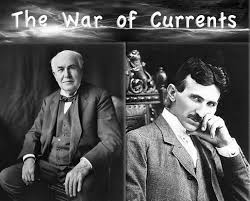Nikola Tesla battled with Thomas Edison over hundred years over the question which is better AC or DC?
Tesla won the war with Edison and AC became the world standard for almost everything electric with one big exception. Batteries are still DC and will always be DC. As a consequence, it is really cheap to pair a DC motor with DC current from a battery. However, just because one route is cheap doesn't mean it is the best one.
At ETryko we decided the proper approach to running a long distance heavy working tricycle is to first convert the DC current from the batteries into AC current and use an AC motor.
It is an expensive approach. An AC motor is almost twice the price and the AC converter/motor speed controller is more expensive than the electric motor. So why do we do it? The answer in short is because a typical Filipino tricycle driver needs lots of power.
We know you sometimes load ten passengers, carry cement bags, or sacks of rice. We also know the Philippines is not flat and many of you have to contend with steep hills. These high power needs require us to provide you with the highest power possible.
Tesla, the big electric car manufacturer, also uses AC motors in their cars. For early sports models their primary concern was high power too. They wanted to gain attention. So Tesla first used AC motors to prove how fast an electric car can accelerate.
However, Tesla picked AC motors over DC for the Model 3 which needed to demonstrate a long range on a single charge. Why? The important question is not how efficient the motor is, the key question is how efficient is the total system during actual use.
It is true, as an individual component, a DC motor is both lighter and more efficient than an AC motor at high loads. However, most of the time you don't need a huge amount of power. Perhaps you are just driving around looking for passengers, or you are just carrying one or two passengers and are going slow in heavy traffic. It is at times like this the AC motor approach is so much more efficient.
The reason is magnets. DC motors have permanent magnets that are designed for maximum speed and are not adjustable. AC motors are not built with permanent magnets and instead generate a magnetic field using some of the electric power. The magnetic effect in an AC motor is generated by electromagnets. An AC motor controller adjusts voltage to the electromagnets based upon how much load the motor is under.
When the AC motor is under a light load, which is most of the time, the AC controller reduces the voltage to the electromagnets and the motor becomes more efficient.
A DC motor does not have this flexibility and as a consequence is not a good choice for a motor that operates at a slow speed most of the time.
The third strike against DC motors is they are not good sources of power at low speeds. Power comes from an electric motor and goes back to the battery during regenerative braking. Regenerative braking in a DC motor only can provide energy back to the battery when the motor generates a voltage higher than the battery voltage. When the tricycle is going fast down a hill using a DC motor, regenerative braking will generate a high enough voltage to charge the battery. When coming to a stop from a slow speed in stop and go traffic, a DC motor might actually consume energy instead of regenerating it. An AC motor doesn't suffer this problem since it converts the AC current generated during braking into DC current before the energy is returned to the battery. Since tricycles are more likely to be spending long periods of time in slow stop and go traffic the AC option will return far more net energy to the batteries.

No comments:
Post a Comment